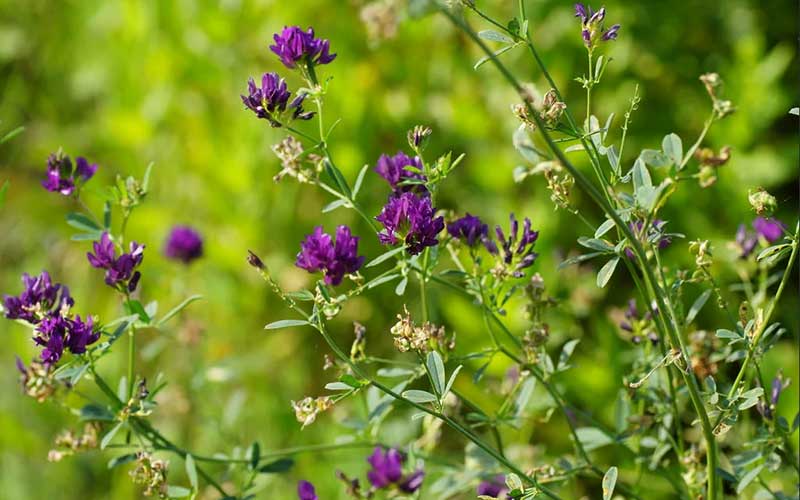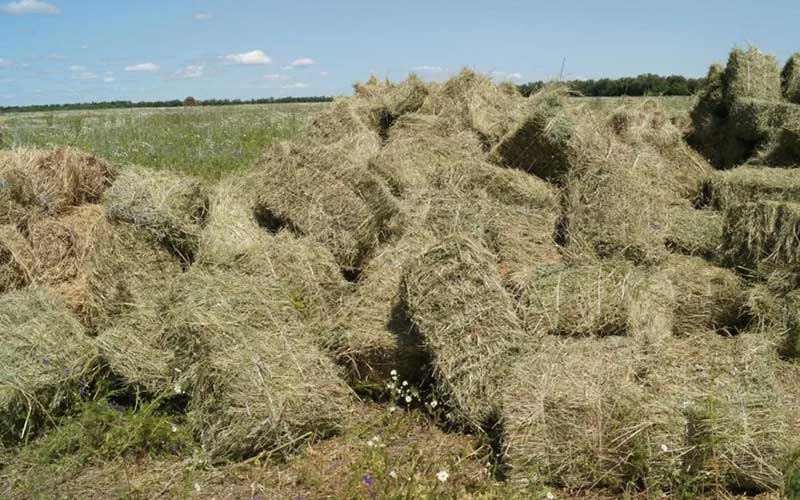
This is where you find all our press releases and news articles.
Lucerne is a popular crop across the continent but remains an almost untapped protein resource in the UK. However, it has huge potential in dairy diets to help displace imported soya and help UK farmers become self-sufficient in homegrown protein.

Lucerne Alfalfa
Rhian Price speaks to a grower and a dairy farmer seeing good results from feeding the legume.
Arable farmer Simon Gittins started growing lucerne four years ago and is so impressed with the crop he hopes to double the amount grown to 81ha (200 acres) in the next couple of years.
Mr Gittins grows 1,275ha (3,150 acres) of eight different crops and reckons lucerne has the potential to be the most profitable of all.
“Lucerne is bang on message in modern UK agriculture,” he says. ”It’s a legume so there is no need for sprays or nitrogen fertiliser. You are basically going zero-till for four years.”
Farming 1,275ha (3,150 acres), half owned with the balance contract-farmed or on various rental agreements
Growing wheat, rape, maize, sugar beet, hybrid rye, lucerne, grass, forage rye and turnips.
He has a 1.9MW anaerobic digester and is installing a second ground-source heat system this year to take the farm’s total renewable drying floor capacity up to 5.6MW.
This is used to dry all of the farm’s cereals and OSR as well as grass and lucerne to produce high-protein, highly digestible hay. This is baled and sold locally.
“I think we will see a move towards providing more homegrown protein to displace high-food-mile soya from South America,” he says.
Mr Gittins grows the varieties Timbale and Galaxy. Seed is planted into free-draining soils in late spring, following crops of hybrid rye, forage rye or grass.
“Establishment is critical with lucerne. We create a stale seed-bed and then drill conventionally, ensuring the field is firm and level.”
He says it is a low-cost crop to grow. Establishment and variable costs equate to £247/ha (£100/acre). Harvesting and baling takes it up to about £618/ha (£250/acre).
Solid digestate is applied at a rate of 25t/ha, primarily for potash, before sowing, or to already-established crops before first cut in the spring. This provides all the potash the plant requires for that season, with little else applied because the crop fixes its own nitrogen.
Four cuts are taken annually, with a fully established crop typically yielding 11t DM/ha (4.5t/acre) at 20-25% protein.
Much of the protein (70%) is found in the leaf of the plant. This poses a problem for field-dried lucerne hay as the leaf can shatter and be left in the field.
To avoid this, Mr Gittins has fine-tuned his approach to harvesting. He mows it and picks it up within 24 hours using a forage box with the knives removed.
“This ensures the leaf is retained and enables us to achieve protein analyses of 20-25%,” he says. “This is appreciably higher than most other lucerne hay on the market.”
Lucerne is taken to the drying sheds where it is spread evenly over the drying floors and stays for four to seven days until it reaches 85-90% DM.
Mr Gittins has converted former potato stores into drying sheds. Ground-source and waste heat from the AD plant are used to dry the lucerne. He uses a Welvent system which draws ambient air through heat exchangers and then forces the warmed air underneath wooden slatted drying floors, on top of which sits the crop.
The crop is baled straight from the drying floor using a Claas 3200 baler. Mr Gittins has imported a HayXit19 from Switzerland to allow stationary baling. It is the first of its kind in the world and cost about £40,000.
Before he set up the static baler, a diet feeder was used to dispense the hay in a swath on the concrete. The tractor and baler would then drive up and down picking up the lucerne.
It was a laborious process, baling only 3-4t/hr. The HayXit19 can bale six times as much – 25t/hr.

The 500kg quadrant bales are sold to dairy farmers for £200-240/t, depending on distance. They are delivered in 20t loads on lorries with curtain sides to prevent leaf being lost in transport.
This autumn the first 20ha Mr Gittins sowed four years ago will return to standing cropping. He is keen to see what impact this will have on soil fertility.
“We will be sowing wheat after lucerne this autumn. We are hoping to see a reduction in variable costs from reduced fertiliser and spray requirements, and a possible increase in yield due to improved soil health and structure.”
Site Must be established into free-draining soil with a pH of 6.2-6.4 and soil indices of at least 2 for potash and phosphate.
Selecting a variety Choose a dormancy rating of 4-5 and a variety with a thin stem to promote synergistic wilting speed with the leaf.
Fertiliser Requires 8kg of phosphate and 30kg of potash per tonne grown. It fixes its own nitrogen, so it requires fertiliser only where it follows a nitrogen-hungry crop such as wheat.
Cost £1,100-1,200/ha to establish (includes seed and machinery costs). Input requirements are very low and would suit organic farms.
Establishment Requires a tight, finely compacted seed-bed. Three options for sowing: Drill it; broadcast the seed and run over it with power harrow, then roll it; or sow with a nurse crop such as spring barley (at 50-75% rate) to help it outcompete weeds. When the barley is 7.5-10cm, lucerne should be drilled and spring barley can be whole-cropped.
Seed depth No deeper than 1cm as the seed is small and won’t emerge if deeper.
Timing Sow from 15 April onwards into warm soil.
Harvest Cut the crop no lower than 7-10cm from the base. The base is high in lignin, which can’t be digested by the cow. Wilt for 24-36hours, weather dependent. Can be baled or clamped.
Additive Crop is high in protein, so an additive is recommended to rapidly bring down pH.
Persistency 4-6 years.
Expected yield 12-14t DM/ha at 18-25% protein.
Related News
Reasons why the grass/alfalfa pellet machine oil pump is not oiling
Alfalfa Feed Pellet Plant Build Alfalfa Pellet Production Line
Can the Alfalfa Pellets Produced by the Feed Pellet Machine Be Fed to Horses?
Large-scale Feed Pellet Plant 5t/h Ring Die Alfalfa Pellet Machine for Sale
Having the right mix of reliable, high-quality pellet machine and pelletizing systems and expert support is essential to your success. Watch how our end-to-end feed pellet plant solutions have helped our customers optimize their performance.
Our customized and future-proofed turnkey pellet plant solutions is designed with you at the core. From vision to reality and beyond, our team stays connected with yours. Giving you peace-of-mind with an expert at your side.

At RICHI, we go beyond project completion. With RICHI Servicee, we’re your dedicated partners in success. Count on us for expert guidance, minimal downtime, and optimized productivity. Choose RICHI for unmatched service and support.



Meet global product demands and quality standards with industry-leading pellet plant design, engineering, equipment, and construction services for pellet processors.


Your Partner Beyond Project Completion
2000+ cases
RICHI is the leading designer, manufacturer and builder of pellet plants in the world, completing over 2000 projects in 140 countries across 6 continents.
Read More
Increase plant productivity, profitability, and safety by integrating high quality equipment into your pellet production line. Over the years, RICHI has become China's top pellet equipment manufacturer. At the same time, RICHI has established valuable partnerships with the world's leading component and raw material manufacturers to bring you the best there is in technology, automation, and efficiency in pelleting plant machinery.

For nearly 30 years, RICHI has been providing best-in-class pellet plant equipment and services to clients across a variety of industries, sizes, and needs. We pride ourselves on the knowledge and skill that each team member possesses – from our technical sales team to our process design engineers. You can count on RICHI Machinery to take your operation to the next level of innovation, quality, and success.
Need help with your pellet manufacturing plant project? Contact us today.
ANIMAL FEED
BIOMASS
WOOD
ORGANIC FERTILIZER
AQUA FEED
CAT LITTER
MUNICIPAL WASTE RECYCLING
SPECIAL PELLET PRODUCTION
RICHI Machinery continues to deliver world class pellet mill equipment, pellet plant engineering and project solutions that add value to our customers in the animal feed, wood waste, agriculture waste, organic fertilizer, cat litter and special pellet products industries. Throughout the years, we RICHI Machinery have built strong brand, becoming industry-leading pellet machine manufacturer. We value integrity, promise quality, and prioritize your success.
Learn MoreWith our expert team, we precisely implement your process engineering requirements in pellet mill and pelletizing plant systems. No matter which industry you’re in – we understand your needs and deliver solutions that meet the highest standards.
At RICHI, quality comes first. Our pellet making machine and related pellet line equipment undergo rigorous quality controls to ensure they meet the highest standards. Rely on products that are durable, safe, and efficient.
With decades of experience in pellet machine and pellet production line production, we have earned a reputation as a trusted partner in various industries. Our expertise allows us to cover a wide range of applications.
Not only do we offer premium pelleting equipment, but we are also experts at designing, building, installing, and maintaining facilities from the ground up. Our expertise is within pellt plant process design, discovering the most efficient, productive, and profitable way to handle your materials in an end-to-end cycle.

Keeping in touch with us is an effective way to solve all your problems. If you have any needs or questions, please leave your contact information, then RICHI technical consultants will send design, quotation, videos to your mailbox. You can also contact us directly via WhatsApp: +86 13838389622
Copyright©2015-2024 by HENAN RICHI MACHINERY CO., LTD. All rights reserved.